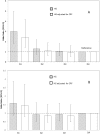Low muscle strength is associated with metabolic risk factors in Colombian children: the ACFIES study
- PMID: 24714401
- PMCID: PMC3979680
- DOI: 10.1371/journal.pone.0093150
Low muscle strength is associated with metabolic risk factors in Colombian children: the ACFIES study
Abstract
Purpose: In youth, poor cardiorespiratory and muscular strength are associated with elevated metabolic risk factors. However, studies examining associations between strength and risk factors have been done exclusively in high income countries, and largely in Caucasian cohorts. The aim of this study was to assess these interactions in schoolchildren in Colombia, a middle income Latin American country.
Methods: We measured body mass index, body composition, handgrip strength (HG), cardiorespiratory fitness (CRF) and metabolic risk factors in 669 low-middle socioeconomic status Colombian schoolchildren (mean age 11.52±1.13, 47% female). Associations between HG, CRF and metabolic risk factors were evaluated.
Results: HG and CRF were inversely associated with blood pressure, HOMA index and a composite metabolic risk score (p<0.001 for all) and HG was also inversely associated with triglycerides and C-reactive protein (CRP) (both p<0.05). Associations between HG and risk factors were marginally weakened after adjusting for CRF, while associations between CRF and these factors were substantially weakened after adjusting for HG. Linear regression analyses showed inverse associations between HG and systolic BP (β = -0.101; p = 0.047), diastolic BP (β = -0.241; p> = 0.001), HOMA (β = -0.164; p = 0.005), triglycerides (β = -0.583; p = 0.026) and CRP (β = -0.183; p = 0.037) but not glucose (p = 0.698) or HDL cholesterol (p = 0.132). The odds ratios for having clustered risk in the weakest quartile compared with the strongest quartile were 3.0 (95% confidence interval: 1.81-4.95).
Conclusions: In Colombian schoolchildren both poorer handgrip strength/kg body mass and cardiorespiratory fitness were associated with a worse metabolic risk profile. Associations were stronger and more consistent between handgrip and risk factors than between cardiorespiratory fitness and these risk factors. Our findings indicate the addition of handgrip dynamometry to non-invasive youth health surveillance programs would improve the accuracy of the assessment of cardio-metabolic health.
Conflict of interest statement
Figures




References
-
- Artero EG, Ruiz JR, Ortega FB, Espana-Romero V, Vicente-Rodriguez G, et al. (2011) Muscular and cardiorespiratory fitness are independently associated with metabolic risk in adolescents: the HELENA study. Pediatric Diabetes. 12: 704–12. - PubMed
-
- Steene-Johannessen J, Anderssen SA, Kolle E, Andersen LB (2009) Low muscle fitness is associated with metabolic risk in youth. Medicine & Science in Sports & Exercise 41: 1361–7. - PubMed
-
- Martinez-Gomez D, Gomez-Martinez S, Ruiz JR, Diaz LE, Ortega FB, et al. (2012) Objectively-measured and self-reported physical activity and fitness in relation to inflammatory markers in European adolescents: the HELENA Study. Atherosclerosis 221: 260–7. - PubMed
-
- Benson AC, Torode ME, Singh MA (2006) Muscular strength and cardiorespiratory fitness is associated with higher insulin sensitivity in children and adolescents. International Journal of Pediatric Obesity 1: 222–31. - PubMed
-
- Trudeau F, Shephard RJ, Arsenault F, Laurencelle L (2003) Tracking of physical fitness from childhood to adulthood. Canadian Journal of Applied Physiology. 28: 257–71. - PubMed
Publication types
MeSH terms
Substances
LinkOut - more resources
Full Text Sources
Other Literature Sources
Medical
Research Materials
Miscellaneous

